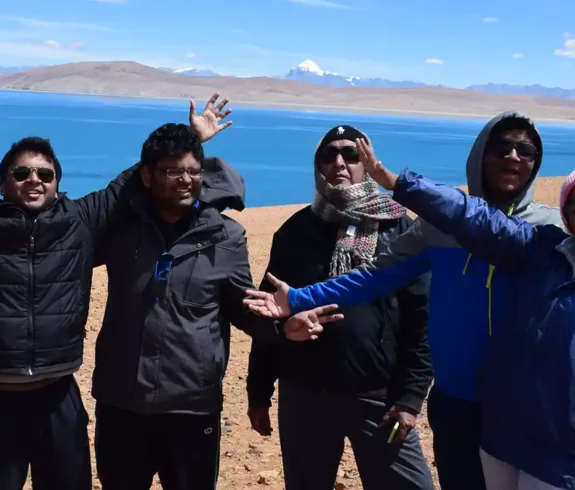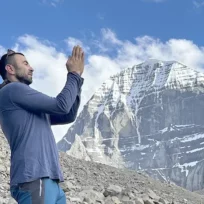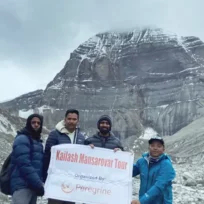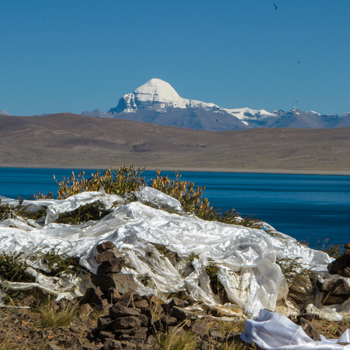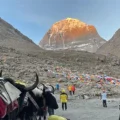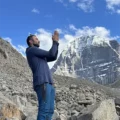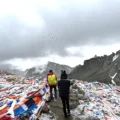Experiencing the Kailash Mansarovar Yatra from the USA offers a physical adventure and a deeply spiritual journey. Mount Kailash, located in Tibet, is considered a holy site by followers of Hinduism, Buddhism, Jainism, and Bon. Completing a pilgrimage to this revered peak and the serene Lake Mansarovar is a spiritual blessing and a path to inner peace. Travelers from the United States often have many questions about planning such a significant trip, from the routes to take to the preparations needed.
This guide covers all the essential details for organizing your Kailash Mansarovar Yatra from the USA, including travel routes, costs, fitness requirements, and practical tips for a seamless experience. Let’s dive into everything you need to know to realize this dream.
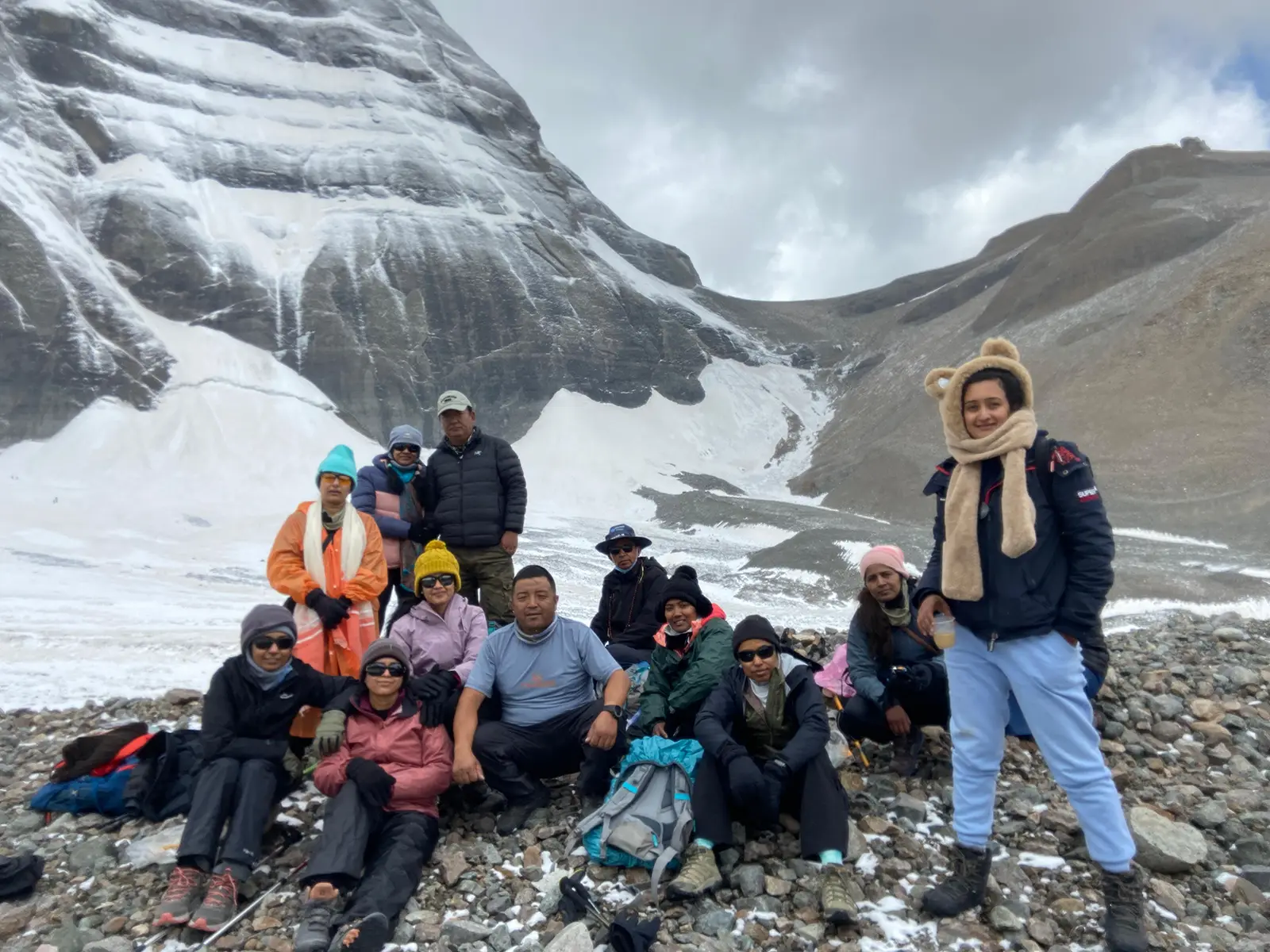
Overview of the Kailash Mansarovar Yatra from the USA
Mount Kailash and Lake Mansarovar are Asia’s most spiritually significant sites. Located in a remote area of Tibet, Mount Kailash is a divine peak revered by Hinduism, Buddhism, Jainism, and Bon followers. Devotees believe completing a pilgrimage to this mountain can cleanse sins and bring spiritual enlightenment.
Lake Mansarovar, nearby, is also religiously significant. Its crystal-clear waters purify the mind and soul, offering a substantial experience for those who bathe or meditate there. These spiritual traditions have drawn thousands to the region every year. The Kailash Mansarovar Yatra from the USA continues to capture the interest of people seeking a spiritual connection and a memorable cultural experience.
In this article, you will learn:
- The deep spiritual significance of Mount Kailash and Lake Mansarovar.
- Why the Kailash Mansarovar Yatra remains a rare spiritual experience.
- Fascinating legends that elevate the mystique of these sacred places.
Keep reading to explore what makes the Kailash Mansarovar Yatra so unique.
Spiritual Significance of Mount Kailash
At over 22,000 feet, Mount Kailash is not just another Himalayan peak. It is considered the “Axis Mundi” or the center of the world, symbolizing a cosmic connection between heaven and earth. Hindus revere Kailash as the abode of Lord Shiva, the supreme god who resides here in a meditative state with his consort, Parvati. Buddhists, on the other hand, view it as the manifestation of Demchok, a representation of ultimate bliss and enlightenment. Jains believe it to be where the first Tirthankara attained liberation; followers of the Bon religion regard it as a center of spiritual power.
Lake Mansarovar, adjacent to the sacred mountain, is equally revered. According to Hindu legend, Brahma created it from his mind, hence its name, which translates to “Lake of the Mind.” The lake’s waters are believed to grant spiritual cleansing and purification.
Why It’s a Unique Experience
Undertaking the Kailash Mansarovar Yatra from the USA means more than just visiting a sacred site. The combination of high-altitude landscapes, religious rituals, and challenging terrain makes it a life-changing event. Pilgrims often feel an unexplainable spiritual connection while walking around Mount Kailash, a practice known as “Kora.” The complete Kora is 52 kilometers long and tests physical endurance and mental strength.
The harsh, pristine environment adds to the adventure. Pilgrims cross rivers, navigate rugged trails, and battle thin air, creating an unmatched sense of accomplishment. Cultural interactions with local Tibetan communities also add richness to the Yatra.
Myths and Legends That Add to the Experience
Mount Kailash is shrouded in mystique, enhanced by centuries-old myths and legends. One famous story among Hindus describes how Lord Shiva and Parvati reside on the mountain, blessing devotees who complete the pilgrimage with good fortune. For Buddhists, it is said that Milarepa, a Tibetan Buddhist master, triumphed over his Bon religion rival in a magical showdown here, establishing the mountain as a place of great spiritual power.
Other curious legends surround the geography. Some pilgrims claim the mountain emits energy that enhances meditation and heightens consciousness. Rumors persist about time slowing down or compasses malfunctioning near the peak. The aura of mystery makes Mount Kailash and Lake Mansarovar not just sites of religious reverence but also places of spiritual intrigue.
Discovering the legends, feeling the energy, and embracing the physical challenge make the Kailash Mansarovar Yatra from the USA an unforgettable spiritual endeavor.
Travel Routes and Options from the USA
Planning a Kailash Mansarovar Yatra from the USA involves careful consideration of flights and travel routes. Major US cities offer several options for reaching transit hubs before heading to Tibet. Understanding these choices can make the Yatra more manageable and efficient.
Flight Options from Major US Cities
Several major cities, including New York, Los Angeles, and Chicago, provide frequent flights to key international transit points. Airlines like Qatar Airways, Emirates, and Air India offer flights to Qatar, Dubai, and New Delhi destinations. These connections are essential for moving to Kathmandu, the starting point for the Kailash Mansarovar Yatra.
For instance, flying from New York to New Delhi usually involves a stopover, with total travel time ranging from 14 to 18 hours. Los Angeles to Kathmandu, another standard route, may take around 20 hours, including layovers. Booking tickets well in advance ensures better prices and flexibility.
Connecting Flights and Layovers
Traveling from the USA to the Kailash Mansarovar region requires connecting flights. Most itineraries involve at least one or two layovers. For example, flying from Chicago to Kathmandu typically requires a stop in the Middle East or a major Asian city. Common layover airports include Doha, Dubai, and Bangkok. These layovers may vary from a few hours to overnight stays, so planning for rest or hotel accommodations may be necessary.
Once in Kathmandu or Lhasa, local flights or road transport can bring you closer to Mount Kailash and Lake Mansarovar. It is crucial to account for these additional travel legs when planning the trip.
Popular Itineraries for the Kailash Tour from the USA
Two main itineraries are popular among travelers from the USA.
Via Nepal (Kathmandu Route)
- Fly from the USA to Kathmandu, Nepal.
- Spend three official nights acclimatizing and completing visa formalities.
- Continue with a road trip to the Tibetan border and drive to Saga, Lake Mansarovar, and Darchen.
- Take part in the Kora (circumambulation) of Mount Kailash and visit.
Via Tibet (Lhasa Route)
- Fly from the USA to Lhasa and Tibet, stopping in mainland China, such as Chengdu, Shanghai, Beijing, etc.
- Acclimatize in Lhasa for two to three days to adjust to the high altitude.
- Travel by road to Darchen, the base camp for Mount Kailash.
- Proceed with the Kora around Mount Kailash.
Both itineraries offer unique experiences and scenic views, so selecting the one that best fits your schedule and interests is essential.
Air and Land Travel Options
Once you reach Asia, air and land travel become crucial. From Kathmandu, several options, like road trips and helicopter services, can take you closer to Mount Kailash. Road trips from Nepal to Tibet involve picturesque landscapes but can be long and tiring. Helicopter services from Simikot to Hilsa, near the Tibet border, save time but may be more expensive.
To reach the pilgrimage sites in Tibet, you can travel by bus or jeep. The road from Lhasa offers breathtaking views of the Tibetan plateau, making the drive an adventure. Be prepared for high-altitude conditions and plan for adequate rest and acclimatization.
Efficient planning ensures a smooth and memorable Kailash Mansarovar Yatra from the USA. Understanding flight options, routes, and itineraries will help you prepare for this incredible spiritual experience.

Yatra Preparation & Prerequisites
Preparing for the Kailash Mansarovar Yatra from the USA requires careful planning and organization. Obtaining the proper documents, ensuring adequate insurance, building physical fitness, and packing the essentials all play a crucial role in making your experience successful and safe.
Visa and Travel Permits
Traveling to Mount Kailash and Lake Mansarovar involves entering Nepal and Tibet. US citizens must secure a visa for Nepal, which is available on arrival at Kathmandu’s Tribhuvan International Airport. A Chinese passport and a special Tibet Travel Permit are mandatory for entering Tibet. Peregrine helps to secure these documents and arranges Mount Kailash and Lake Mansarovar permits issued by Tibetan authorities. Plan at least two months to ensure all documents are ready.
Travel Insurance
Travel insurance from the USA is essential for the Kailash tour. Policies should cover high-altitude trekking, medical emergencies, evacuation, and trip cancellations. Medical emergencies at high altitudes can require expensive air evacuation. Ensure your insurance policy specifies coverage for these scenarios. Many travel insurance providers offer customized plans for trekking in remote and high-altitude areas.
Physical Fitness Requirements
Due to challenging conditions and thin air at high altitudes, the Kailash Mansarovar Yatra demands a high level of physical fitness. Preparing well can help prevent altitude sickness and fatigue—regular physical training like running, swimming, or cycling to improve endurance. Breathing practices, like pranayama, strengthen lung capacity and help your body adapt to thin air. Trekking with a weighted backpack can also build the stamina needed for the Kora around Mount Kailash.
Packing Essentials
Packing correctly for high-altitude trekking ensures a safer and more comfortable experience. Essential items include:
- Warm Clothing: Thermal layers, fleece jackets, and down coats for sub-zero temperatures.
- Trekking Boots: Waterproof boots with ankle support to navigate rugged terrain.
- First-Aid Kit: Include altitude sickness medication, pain relief, bandages, and personal prescriptions.
- Hydration Gear: Insulated water bottles and hydration packs to stay hydrated in dry, cold conditions.
- High-Altitude Gear: Sunglasses, sunscreen, and lip balm for UV protection.
- Food and Snacks: High-energy bars, dry fruits, and trail mix for nourishment on long treks.
- Other Essentials: Lightweight sleeping bag, trekking poles, portable oxygen cylinders, and a waterproof backpack.
Careful preparation and the right gear make the Kailash Mansarovar Yatra from the USA a pilgrimage and a memorable and safe adventure. Travelers who are adequately equipped and physically fit can enjoy a spiritual and transformative experience.
Best Time to Visit
Planning the Kailash Mansarovar Yatra from the USA requires choosing the right time for a safe and enjoyable experience. The ideal months for the Yatra are April to September, which offer the best weather conditions for high-altitude travel.
Ideal Months: April to September
The Kailash Mansarovar region opens up for pilgrims and tourists from April to September. The weather is more predictable during this period, and roads and trails remain accessible. Clear skies in these months provide stunning views of Mount Kailash and Lake Mansarovar, making the spiritual and scenic experience truly rewarding.
Weather Conditions Explained
April marks the start of the Yatra season, with temperatures beginning to warm up. Snow starts melting, making mountain passes navigable. By May and June, the weather stabilizes, and temperatures remain moderate, ranging from 5°C to 15°C during the day. Nights can still get very cold, so warm clothing is essential.
July and August bring the monsoon season to Nepal, but Tibet remains primarily dry, as the region lies in a rain shadow. Occasional rainfall can still occur, but the pilgrimage continues uninterrupted. September offers pleasant weather with mild temperatures and fewer crowds, marking the end of the Yatra season.
Selecting the right time ensures a smoother Kailash tour from the USA, with less risk of harsh conditions and a higher chance of enjoying breathtaking views. Proper timing makes the experience both spiritually fulfilling and logistically manageable.
Cost and Budget Breakdown
Planning a Kailash Mansarovar Yatra from the USA involves understanding the costs and options available. Packages range from budget-friendly to luxury, allowing travelers to select as per their preferences. Peregrine Treks offers several comprehensive packages for this spiritual adventure.
Package Options for the Yatra
Kailash Overland Tour from Lhasa
This package starts in Lhasa and offers travelers a scenic overland journey to Mount Kailash. The tour includes acclimatization days in Lhasa, guided tours, and a road trip through the Tibetan landscape. Expect breathtaking views and a memorable experience.
More details: Kailash Overland Tour
Kailash Mansarovar Yatra with Kathmandu Sightseeing
Travelers looking to explore Nepal along with their pilgrimage can choose this package. It begins in Kathmandu, with visits to iconic temples and landmarks before heading toward the Tibetan border for the Yatra.
More details: Kailash Mansarovar Yatra
Budget Option from Nepal
Ideal for those looking to minimize costs, this package starts in Nepal and focuses on the essentials. It offers basic accommodations and group travel, maintaining a high-quality experience at a more affordable rate.
More details: Mount Kailash Tour from Nepal
Cost Estimates
The cost of a Kailash Mansarovar Yatra from the USA varies based on the chosen package and trip duration. Below is an estimated breakdown of the potential expenses:
- Flights: $1,500 to $2,500 (round trip from major US cities to Kathmandu or Lhasa)
- Accommodation: $40 to $200 per night, depending on the level of comfort
- Permits and Visas: $200 to $300, including Chinese visa and Tibet Travel Permit
- Guides and Transportation: $1,500 to $2,000, often included in package deals
- Meals: $10 to $30 per day, depending on preferences
- Miscellaneous Expenses: $300 to $500, covering souvenirs, tips, and emergency funds
Money-Saving Tips
- Book Flights Early: Airline tickets are often cheaper when purchased several months in advance. Planning can help you lock in lower fares.
- Join a Large Group: Travel in a group of 10 or more people to receive discounts on your package. Peregrine Treks offers a 50% discount for group leaders over ten and a 100% discount for groups over 15.
- Choose Budget Packages: Opt for more economical packages that provide basic services while covering essential experiences. You can lower expenses while maintaining safety and quality.
- Avoid Peak Season: Traveling slightly outside peak months can save money on accommodations and services.
Thoughtful planning and smart choices can make the Kailash Mansarovar Yatra USA accessible to people with a wide range of budgets. Whether choosing a budget option or a luxury experience, being prepared helps ensure a rewarding and affordable spiritual adventure.

Accommodation and Food Options
Understanding where to stay and what to eat during the Kailash Mansarovar Yatra from the USA helps ensure a comfortable and well-prepared experience. From basic guesthouses to specialized dining options, the Yatra route offers a mix of essentials and simple comforts.
Types of Accommodation
Various lodging options are available to travelers based on their location along the Yatra.
- Kathmandu and Major Cities in Tibet: Hotels are available in cities like Kathmandu, Kerung, Saga, and Darchen. These hotels range from budget to mid-range, providing basic amenities like hot showers and simple meals. Some higher-end hotels in Kathmandu offer extra comforts, such as Wi-Fi and buffet-style dining.
- Mansarovar, Dirapuk, and Zutulpuk: Lodging in these areas is limited to guesthouses. These accommodations are simple, often featuring shared rooms and basic facilities. Running water and electricity may be inconsistent, so travelers should prepare for a more rustic experience. Campsites are also used at times, providing a more adventurous lodging option.
Choosing suitable accommodation depends on your comfort needs and budget. Some tour operators offer packages with better facilities for those who prefer an added level of support.
Food Availability
Meal options vary across the Yatra route, offering travelers a mix of local cuisine and practical meals. In cities like Kathmandu and Saga, restaurants serve a variety of foods, including Nepalese, Tibetan, and Indian cuisine. Typical meals include rice, noodles, vegetables, and lentil soups, all made with simple ingredients to fuel the body.
In remote areas near Mansarovar, Dirapuk, and Zutulpuk, choices are limited. Local restaurants along the route often serve Tibetan dishes like momos (dumplings), thukpa (noodle soup), and yak meat. Vegetarian options are widely available and are a preferred choice for many pilgrims.
For a more comfortable dining experience, hiring a Nepali Sherpa Cook Team is an option. They prepare meals that meet dietary preferences and bring a sense of home cooking to the trek. This service adds extra cost but ensures reliable nutrition in remote locations.
Staying flexible and open to simple meals helps make the Kailash tour from the USA more enjoyable. Preparing snacks and hydration essentials also contributes to a successful Yatra experience.
Health and Safety Tips
Staying safe and healthy during the Kailash Mansarovar Yatra from the USA requires preparation and awareness. The high altitudes and rugged terrain demand extra caution, especially for travelers who may need to be more accustomed to such environments.
Acclimatization
Acclimatization is crucial to avoid altitude sickness, which can become severe at high elevations. The Yatra route passes through areas where oxygen levels are significantly lower, making it essential to adjust gradually. Spending a few days in Kathmandu or Lhasa before heading to higher altitudes helps the body adapt. Drinking water, avoiding alcohol, and eating light meals reduce the risk of altitude sickness.
Strolling and listening to your body’s signals is critical. Headaches, nausea, dizziness, and fatigue are typical symptoms of altitude sickness. If symptoms become severe, descending to a lower altitude and seeking medical attention is critical.
Medical Facilities
Medical support from the USA is limited along the Kailash tour, so planning is essential. Basic medical facilities are available in Kerung, Saga, and Darchen. These facilities offer treatment for altitude sickness and minor health issues, but complex medical emergencies may require evacuation to larger cities like Kathmandu or Lhasa.
Carrying a personal first-aid kit with essential medications, altitude sickness tablets, and basic supplies adds a layer of protection. Travelers should also inform guides of any pre-existing medical conditions.
Safety Precautions
Traveling with experienced guides and joining a reputable tour group enhances safety. Guides familiar with the terrain and local culture provide critical support and can manage emergencies if they arise. Always follow guides’ advice, especially when dealing with harsh weather or altitude-related issues.
Other safety measures include dressing in layers to prepare for rapidly changing weather, using sunscreen to protect against UV rays, and keeping hydrated. Staying in well-traveled areas and not wandering off alone reduces risks. Investing in travel insurance that covers high-altitude trekking and emergency evacuation ensures additional peace of mind.
Proper acclimatization, awareness of available medical support, and following safety precautions contribute to a safe and meaningful Kailash Mansarovar Yatra USA experience. Prioritizing health and safety makes the spiritual pilgrimage more rewarding and worry-free.

Cultural and Religious Etiquette
Understanding and respecting local customs enriches the Kailash Mansarovar Yatra from the USA. The sacred sites of Mount Kailash and Lake Mansarovar hold deep religious significance, making cultural awareness essential.
Respecting Local Customs and Religious Practices
Mount Kailash and Lake Mansarovar are revered by Hindus, Buddhists, Jains, and followers of Bon. Always treat these sites with the utmost respect. Avoid loud conversations and remain calm, especially during rituals or prayers. Dress in modest attire that covers your shoulders and knees to respect local spiritual traditions.
Taking photos around sacred areas requires caution. Always ask for permission before photographing religious ceremonies, monks, or local people. Photography may be prohibited entirely in some places, so pay attention to signs and guidelines.
Walking clockwise around Mount Kailash, known as “Kora,” is the traditional and respectful way to circumambulate the mountain. Avoid any activities that could be seen as disrespectful, such as climbing the sacred peak or disturbing religious symbols.
Interacting with Local Communities
Engaging with the local Tibetan and Nepalese communities requires sensitivity and understanding. Having a friendly and respectful attitude makes a significant difference. Greet locals with a warm “Tashi Delek” (hello in Tibetan) and remain open to cultural differences. Avoid offering unsolicited advice or making negative comments about local traditions.
When visiting monasteries or temples, remove your shoes and keep quiet. Never point your feet toward religious statues, monks, or elders; it is considered disrespectful. Offering or receiving items with your right hand is considered polite, and pointing at people with a finger or objects should be avoided.
Respecting locals and religious practices fosters positive interactions and deepens the spiritual experience of the Kailash tour from the USA. Practicing cultural etiquette demonstrates appreciation for the region’s sacredness and creates meaningful connections.
Travel Tips and Recommendations
Preparing for the Kailash Mansarovar Yatra from the USA involves more than packing your bags. High-altitude trekking and unpredictable conditions demand careful planning and innovative strategies to ensure a successful and safe experience.
Dealing with High-Altitude Trekking Challenges
High-altitude trekking can strain your body, especially for travelers not used to low oxygen levels. To manage these challenges:
- Acclimate Slowly: Spend a few days at high altitudes, like in Kathmandu or Lhasa, before heading to Mount Kailash.
- Stay Hydrated: Drink plenty of water to help your body adjust to the altitude.
- Eat Light Meals: Avoid heavy, greasy foods that may upset your stomach.
- Know the Symptoms: Watch for signs of altitude sickness, such as headaches or dizziness, and inform your guide immediately. Taking altitude sickness medication can also help.
Useful Apps and Resources
Technology can make the Kailash tour from the USA smoother and more manageable. Consider downloading these apps:
- Navigation: Maps.me offers offline maps, which work well in remote regions.
- Language Translation: Google Translate is a handy tool for communicating with locals. Download languages offline to use without an internet connection.
- Weather Updates: AccuWeather or Weather.com provides up-to-date forecasts for planning daily activities and staying prepared.
Using the right apps can reduce stress and improve your overall experience on the Yatra.
Dealing with Unexpected Circumstances
High altitudes and unpredictable weather make flexibility essential. Weather delays, road closures, or health issues may disrupt plans.
- Stay Calm: Unexpected delays are expected. Please take it as an opportunity to rest and acclimate.
- Carry Essentials: For unplanned stops, keep extra snacks, water, and warm clothing handy.
- Seek Medical Attention: If you have serious health problems, don’t hesitate to consult a medical professional. Guides are equipped to manage emergencies and can assist with arranging evacuation if needed.
Being adaptable and prepared helps ensure a safer and more enjoyable Kailash Mansarovar Yatra USA experience. Taking these precautions keeps the adventure smooth, meaningful, and memorable.
Conclusion and Call to Action
The Kailash Mansarovar Yatra from the USA offers a spiritual and adventurous experience. Mount Kailash and Lake Mansarovar hold deep religious significance and awe-inspiring natural beauty, making the pilgrimage both transformative and unforgettable. From trekking through breathtaking landscapes to embracing the rich cultural and spiritual atmosphere, the Yatra promises an experience that leaves a lasting impact.
Planning early ensures a smoother experience. High-altitude travel, permits, and accommodations require organization, and choosing a reputable tour operator guarantees safety and peace of mind. Tour operators assist in managing complex travel logistics, ensuring your Kailash tour from the USA is hassle-free.
Ready to take the first step on this life-changing pilgrimage? Start your spiritual adventure today and connect with Peregrine to plan your unforgettable Kailash Mansarovar Yatra USA experience!
